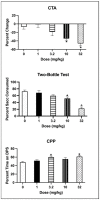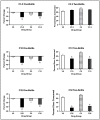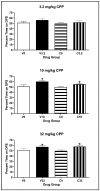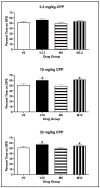Effects of Serial Polydrug Use on the Rewarding and Aversive Effects of the Novel Synthetic Cathinone Eutylone
- PMID: 37759895
- PMCID: PMC10526358
- DOI: 10.3390/brainsci13091294
Effects of Serial Polydrug Use on the Rewarding and Aversive Effects of the Novel Synthetic Cathinone Eutylone
Abstract
Background: As individual synthetic cathinones become scheduled and regulated by the Drug Enforcement Administration (DEA), new ones regularly are produced and distributed. One such compound is eutylone, a novel third-generation synthetic cathinone whose affective properties (and abuse potential) are largely unknown. The following experiments begin to characterize these effects and how they may be impacted by drug history (a factor affecting reward/aversion for other drugs of abuse).
Methods: Eutylone was assessed for its ability to induce conditioned taste avoidance (CTA; aversive effect) and conditioned place preference (CPP; rewarding effect) and their relationship (Experiment 1). Following this, the effects of exposure to cocaine or 3,4-methylenedioxymethamphetamine [MDMA] on eutylone's affective properties were investigated (Experiment 2).
Results: Eutylone produced dose-dependent CTA and CPP (Experiment 1), and these endpoints were unrelated. Pre-exposure to cocaine and MDMA differentially impacted taste avoidance induced by eutylone (MDMA > cocaine) and did not impact eutylone-induced place preference.
Conclusions: These data indicate that eutylone, like other synthetic cathinones, has co-occurring, independent rewarding and aversive effects that may contribute to its abuse potential and that these effects are differentially impacted by drug history. Although these studies begin the characterization of eutylone, future studies should examine the impact of other factors on eutylone's affective properties and its eventual reinforcing effects (i.e., intravenous self-administration [IVSA]) to predict its use and abuse liability.
Keywords: MDMA; cocaine; drug history; eutylone; place preference; taste avoidance.
Conflict of interest statement
The authors declare no conflict of interest.
Figures










Similar articles
-
Pre-exposure to eutylone attenuates its own aversive effects but has no impact on cocaine or MDMA: A possible role of eutylone's hybrid pharmacology.Pharmacol Biochem Behav. 2025 Jul;252:174013. doi: 10.1016/j.pbb.2025.174013. Epub 2025 Apr 17. Pharmacol Biochem Behav. 2025. PMID: 40252931
-
Conditioned taste avoidance and conditioned place preference induced by the third-generation synthetic cathinone eutylone in female sprague-dawley rats.Exp Clin Psychopharmacol. 2023 Dec;31(6):1069-1079. doi: 10.1037/pha0000657. Epub 2023 May 25. Exp Clin Psychopharmacol. 2023. PMID: 37227884
-
Comparative Assessment of the Addictive Potential of Synthetic Cathinones by Zebrafish Conditioned Place Preference (CPP) Paradigm.Life (Basel). 2024 Jun 27;14(7):820. doi: 10.3390/life14070820. Life (Basel). 2024. PMID: 39063573 Free PMC article.
-
The Affective Properties of Synthetic Cathinones: Role of Reward and Aversion in Their Abuse.Curr Top Behav Neurosci. 2017;32:165-181. doi: 10.1007/7854_2016_32. Curr Top Behav Neurosci. 2017. PMID: 27431397 Review.
-
Reinforcing Effects of Cathinone NPS in the Intravenous Drug Self-Administration Paradigm.Curr Top Behav Neurosci. 2017;32:133-143. doi: 10.1007/7854_2016_33. Curr Top Behav Neurosci. 2017. PMID: 27431398 Review.
Cited by
-
Structure-Activity Relationship of Synthetic Cathinones: An Updated Review.ACS Pharmacol Transl Sci. 2024 Aug 6;7(9):2588-2603. doi: 10.1021/acsptsci.4c00299. eCollection 2024 Sep 13. ACS Pharmacol Transl Sci. 2024. PMID: 39296271 Free PMC article. Review.
-
Synthetic Cathinones: Epidemiology, Toxicity, Potential for Abuse, and Current Public Health Perspective.Brain Sci. 2024 Mar 29;14(4):334. doi: 10.3390/brainsci14040334. Brain Sci. 2024. PMID: 38671986 Free PMC article. Review.
References
-
- Riley A.L., Simpson G.R. The attenuating effects of drug preexposure on taste aversion conditioning: Generality, experimental parameters, underlying mechanisms, and implications for drug use and abuse. In: Mowrer R.R., Klein S.B., editors. Handbook of Contemporary Learning Theories. Lawrence Erlbaum Associates Inc.; Mahawah, NJ, USA: 2001. pp. 505–559.
Grants and funding
LinkOut - more resources
Full Text Sources
Medical
Research Materials

